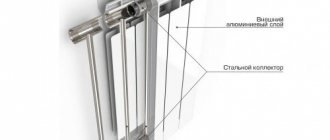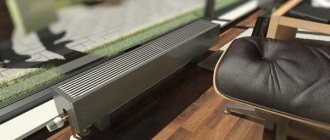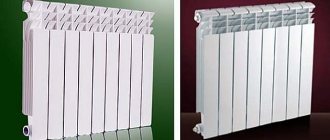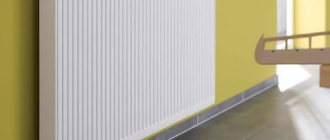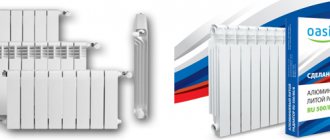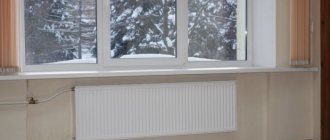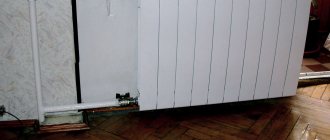Residents of private and multi-storey buildings are increasingly replacing massive and outdated cast iron radiators with modern and visually attractive heating devices. For example, bimetallic radiators, which have strength, durability and heat dissipation. This device consists of an aluminum housing, inside of which there is a frame made of steel or copper pipe. The frame allows you to withstand high pressure and temperature of the coolant. The aluminum body does not require painting and significantly increases the heat transfer of the heating device. In the article below we will look at the best bimetallic heating radiators, study their reviews and characteristics.
Design of bimetallic heaters
The body of these radiators is figured-ribbed, made of aluminum alloy, which is distinguished by excellent heat transfer. Under the housing there is a heating circuit made of pipes (copper or steel).
This “filling” helps the battery adequately withstand the attack of chemical and mechanical impurities present in hot water for heating.
The steel from which the core tubes are made is very strong. Therefore, the radiator will withstand even under high pressure. This can be 20, or even 40 atmospheres (some models up to 100 atmospheres). And the temperature of the coolant can rise to 110 or 130 degrees. If you need more specific numbers, you need to look at the passport of a specific radiator. Aluminum not only increases heat transfer, but also significantly makes the device lighter. In addition, the complex shaped housing has a very attractive design, giving the radiators an excellent appearance.
According to their characteristics, these radiators are quite suitable both for apartments in buildings of various heights, and for individual cottages with autonomous heating systems. But don’t rush to the store right away - first we’ll tell you how to intelligently approach the issue of choosing them.
The best models with side connection
Lateral connection is a standard installation option in apartments. Let's look at the best models of this type. TOP 4 best models according to customer reviews and ratings.
STOUT Space 500
The model has high heat transfer, so it is ideal for both a large apartment and a private house.
The high quality of the coating on the outside and inside makes the structure resistant to chemically aggressive coolants.
The surface is also heavily susceptible to mechanical damage.
The device comes with a 10-year warranty period.
Specifications:
- design - wall-mounted;
- type - sectional;
- connection - lateral;
- maximum operating pressure - 20 bar;
- height - 56.1 cm;
- width of one section - 8 cm;
- thickness - 8 cm;
- weight - one section - 6.4 kg.
Advantages
- stylish design;
- good heat dissipation;
- low cost;
- excellent for standard heating systems;
- high-quality assembly;
- 10 year warranty.
Flaws
- installation components are not included in the kit, you need to purchase them yourself;
- Even small scratches are visible on the surface;
- makes noise when touched.
Royal Thermo Indigo Super 500
A high-quality model with a laconic design, suitable for apartments and individual buildings.
The design is made in such a way that warm air flows go not only upward, but also forward.
This ensures the room warms up as quickly as possible.
Seven-level painting ensures resistance to mechanical damage.
Specifications:
- design - wall-mounted;
- type - sectional;
- connection - lateral;
- maximum operating pressure - 30 bar;
- height - 58.5 cm;
- width of one section - 8 cm;
- thickness - 10 cm;
- the weight of one section is 1.93 kg.
Advantages
- low price;
- exquisite exterior;
- maximum uniform heat distribution;
- high heat transfer;
- you can add sections after installation;
- resistance to water hammer.
Flaws
- the back surface is poorly painted;
- build quality is not always high;
- difficult to clean due to non-standard design.
Royal Thermo Vittoria+ 500
Non-standard fins on these radiators give an unusual appearance to the entire structure.
Finning is not only an aesthetic move, it also increases the performance of the unit, making the room warm and cozy.
Great for rooms up to 20 square meters.
In addition, seven-level painting provides reliable anti-corrosion protection.
Specifications:
- design - wall-mounted;
- type - sectional;
- connection - lateral;
- maximum operating pressure - 30 bar;
- height - 56 cm;
- width of one section - 8 cm;
- thickness - 8.7 cm;
- the weight of one section is 1.65 kg.
Advantages
- stylish design;
- good heat dissipation;
- a light weight;
- high quality coating;
- reliability;
- long warranty period.
Flaws
- high price;
- the quality of the coating is good only on the front side;
- not always high-quality assembly.
Rifar SUPReMO 500
Equipment with a laconic design will be an excellent addition to any modern interior.
The device fully heats medium-sized rooms - up to 15 square meters.
It features fast room heating and high build quality.
Products from a domestic manufacturer, made using European technologies.
Specifications:
- design - wall-mounted;
- type - sectional;
- connection - lateral;
- maximum operating pressure - 30 bar;
- height - 57.5 cm;
- width of one section - 8 cm;
- thickness - 9 cm;
- weight - 8.8 kg.
Advantages
- quickly heats the room;
- high heat transfer;
- rich equipment;
- good build quality;
- noise-insulated model;
- high-quality coating that does not fade over time.
Flaws
- high price;
- the surface is well painted only on the front side;
- heavy weight.
Which is better: a model made of several sections or a one-piece one?
The bulk of bimetallic radiators consists of sections. There are usually an even number of them. These factory-made elements are combined into one common radiator. The joints between all sections have sealed gaskets secured with nipples.
This option is convenient because you can always subtract or add the required number of sections - an experienced craftsman can easily handle this.
The monolithic design is good because it can cope with enormous pressure - up to 100 atmospheres. After all, inside it there is a monolithic steel core, the strength of which is higher than that of a sectional one. The steel pipes are covered with an aluminum shell on top. Although less common than the previous type, such models are also found in stores.
When choosing here, you need to look in the direction of what operating pressure you need; if your centralized network contains powerful water hammers, then choose monolithic devices. But they will be more expensive, so in all other cases it is better to go with sectional ones.
Adviсe
When choosing a bimetallic radiator, it is worth considering several key criteria:
- type - sectional radiators are more flexible in relation to the size and number of sections; if necessary, you can order an option with the required number of elements. Monolithic options are more reliable and have no weak points for leaks. However, sectional radiators are more in demand and are found on the market much more often;
- heat transfer - the higher this indicator, the faster the air will warm up, especially in large rooms. However, installing a radiator that is too large or powerful will lead to overheating of the room and discomfort;
- type of connection - most of the models on the market have a side connection, and it does not matter whether it is right or left. There are also radiators with a bottom connection, less often with a top connection.
Which radiators are more reliable and durable?
Bimetal batteries may differ slightly in the materials used. So, there are two types of radiators.
- The first ones made entirely on a steel frame.
- The latter have only steel-reinforced channels through which hot coolant flows.
Radiators with a steel frame are of higher quality and more reliable. After all, their hot water does not come into contact with the aluminum alloy, so severe corrosion is not observed. Such a product will certainly not leak. At the same time, when choosing a specific model, look at its cost and weight. The heavier the battery, the more expensive it is. Radiators made on a steel frame are produced by such brands as:
- Italian company Global Style;
- Italian company Royal Thermo BiLiner;
- Russian company Santekhprom BM.
- Russian company Rifar - Monolit model
In radiators where the frame is not entirely steel (they are, by the way, called semi-bimetallic), heat transfer is higher. And the cost is about one-fifth less than that of radiators with a steel frame. Three popular manufacturers can also be listed:
- Russian company Rifar (except for the Monolit model);
- Italian company Sira;
- Chinese company Gordi.
If you need a radiator for an apartment in a multi-storey building with a centralized heating system and old pipes, then your choice is a true bimetallic radiator made on a steel frame.
Installation of equipment
The installation of bimetallic heating radiators must be carried out in accordance with the instructions given by the manufacturer. And, of course, the installation must be carried out by a specialist who has a license to carry out this type of work.
Before installing batteries, wash the communications.
A valve will need to be installed on each battery; it can be either manual or automatic and designed to release air from the radiator. To prevent the valve from becoming dirty, special filters are installed on the supply risers to protect against dirt.
Aluminum or bimetallic radiators?
Radiator installation procedure:
- Mark the mounting locations for the brackets;
- Attach the brackets using dowels or cement mortar;
- Connect the battery to the supply lines, this is done using a tap or thermostat;
- Install an air bleed valve at the top of the radiator.
The bimetallic heating radiator must be installed so that the horizontal sections of the heads lie directly on the brackets. It is undesirable to cover radiators with various screens and cabinets, as the operating conditions of the equipment may worsen.
Which manufacturer to choose?
If you are wondering which brand of bimetallic radiator to choose, then we will try to orient you in this variety. It is impossible to say that some well-known radiator manufacturing company is producing one defect. After all, certified goods are usually sold, and therefore there should be no defective products in principle. However, there are some differences between cheap radiators and more expensive ones. For example:
- A little less steel and aluminum are used to make them.
- They are less complex in design.
- Painting work was carried out according to a budget option.
As you can see, these are not so critical parameters. Therefore, batteries that cost about 400 rubles for each section cannot be called completely bad. They are simply not as beautiful, and in terms of pressure they cannot compare with more expensive models. However, they will do their job.
But some of them may also be semi-bimetallic; they will differ sharply in price, this can be immediately understood by looking at price lists and catalogs. We talked about the companies that produce them above.
We most often sell radiators from Rifar, Sira and Global. One section of domestic (Rifar) radiators costs from 350 to 400 rubles. Italian batteries will have more expensive sections - from 420 to 500 rubles apiece. Specifically, you need to go to the store and look at certain models. After all, manufacturing companies produce sections with different thermal power, design and construction. Therefore, you can always choose a radiator based on the amount you have in your wallet.
Table. Comparative characteristics of various manufacturers and models of bimetallic radiators
| Brand, country of origin | Model | Distance between axes, mm | Dimensions, H/W/D (sections) | Maksim. working pressure, bar. | Thermal power, W | Water volume in section, l | Weight, kg | Max. temp. tepono-sitela |
| Italy | STYLE 350 STYLE 500 STYLE PLUS 350 STYLE PLUS 500 | 350 500 350 500 | 425/80/80 575/80/80 425/80/95 575/80/95 | 35 | 125 168 140 185 | 0,16 0,2 0,17 0,19 | 1,56 1,97 1,5 1,94 | 110 |
| Italy | BiLiner Inox 500 BiLiner 500 | 500 | 574/80/87 | 20 | 171 | 0,2 | 2,01 | 90 |
| Germany | TENRAD 350 TENRAD 500 | 350 500 | 400/80/77 550/80/77 | 24 | 120 161 | 0,15 0,22 | 1,22 1,44 | 120 |
| Russia | RIFAR Forza 350 RIFAR Forza 500 RIFAR MONOLIT 350 RIFAR MONOLIT 500 | 350 500 350 500 | 415/90/80 570/100/80 415/100/80 577/100/80 | 20 20 100 100 | 136 202 136 194 | 0,18 0,20 0,18 0,20 | 1,36 1,84 1,5 2,0 | 135 |
| China | Gordi 350 Gordi 500 | 350 500 | 412/80/80 572/80/80 | 30 | 160 181 | 0,21 0,3 | 1,4 1,7 | 110 |
| Italy | Gladiator 200 Gladiator 350 Gladiator 500 | 200 350 500 | 275/80/80 423/80/80 | 30 | 90 140 185 | 0,1 0,13 0,42 | 0,65 0,85 1,6 | 110 |
Selecting the distance between the axes
The functionality of different models of bimetal radiators is usually equivalent. But they differ in the distance between the axes of the collectors.
There are models with both standard values (50 and 35 centimeters) and non-standard ones. For example, if radiators of minimum or maximum height are suitable for your purposes, then keep in mind the following points:
- A small distance between the axles (20 centimeters) is found only in models from BiLUX, RIFAR and Sira.
- A large distance between the axles (about 80 centimeters) occurs only in models made by the Italian company Sira.
We can note some advantages of the products of our manufacturer – RIFAR. He makes a line of RIFAR MONOLIT radiators, which have a solid core. Another line - RIFAR FLEX - can be rounded in accordance with the wishes of the customer.
This is convenient in an apartment where the corners are not straight, but rounded. Such a radiator will fit into the design most optimally and will fit perfectly into the wiring.
How to calculate the number of sections
To understand how many sections will be enough to effectively heat the room, you will need to calculate the area. Based on SNiP (building codes), for 1 m² you will need a battery with a minimum power level of 100 W.
The area of the room is calculated as follows: the length is multiplied by the width, the result is multiplied by the power and divided by the power required for one battery. These are approximate calculations that are relevant for housing with normal ceiling heights.
